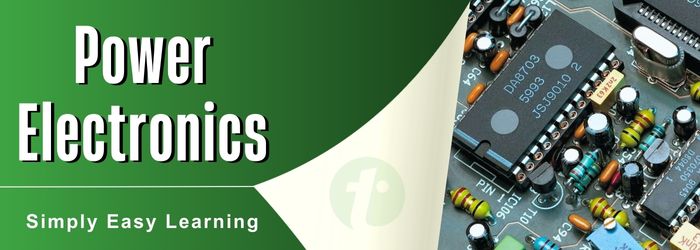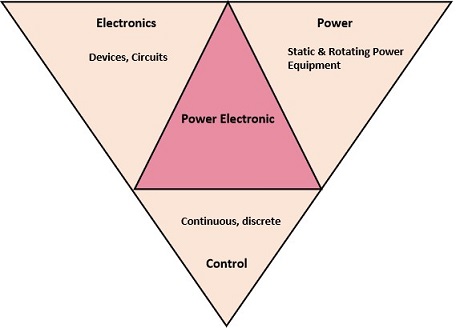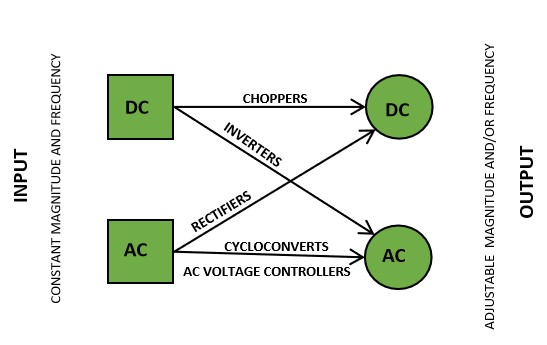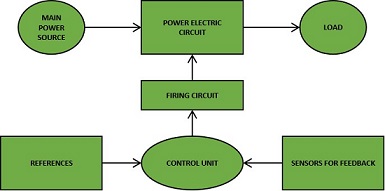
- Power Electronics - Home
- Power Electronics - Introduction
- Power Electronics - Switching Devices
- Linear Circuit Elements
- Power Electronics - Resistor
- Power Electronics - Inductor
- Power Electronics - Power Diode
- Power Diode - Reverse Recovery Characteristics
- Power Electronics - BJT
- Power Electronics - IGBT
- Power Electronics - MOSFET
- Silicon Controlled Rectifier
- SCR - Switching Characteristics
- Power Electronics - TRIAC
- Power Electronics - GTO Thyristor
- Comparision of Power Semiconductor Devices
- Thyristor - Diode Model
- Thyristor - Two Transistor Model
- Thyristor - Turn ON Methods
- Thyristor - Specifications and Ratings
- Solved Example
- Phase Controlled Converters
- Power Electronics - Pulse Converters
- Effect of Source Inductance
- Performance Parameters
- Reactive Power Control of Converters
- Power Electronics - Dual Converters
- Solved Example
- DC to DC Converters
- Power Electronics - Choppers
- Power Electronics - Control Methods
- Resonant Switching
- DC Converters Solved Example
- AC to DC Converters
- Single Phase AC Voltage Controllers
- Power Electronics - Cycloconverters
- Integral Cycle Control
- Power Electronics - Matrix Converters
- Solved Example
- Power Electronics Resources
- Power Electronics - Quick Guide
- Power Electronics - Useful Resources
- Power Electronics - Discussion
Power Electronics Tutorial
Power Electronics refers to an interdisciplinary subject within Electrical Engineering that deals with the design, control and conversion of power in its electric form. A system that converts electric energy to an electric load through a control circuit is known as a Power Electronic System. Power Electronics is about controlling and effectively utilizing our costly Electrical energy by using smart and intellegent electronics.

The objective of this tutorial is to introduce and explain the main concepts in Power Electronics, which include Power Semi-Conductor Devices, Single Phase - Uncontrolled and Controlled Converters, Three Phase - Uncontrolled and Controlled Converters, AC Voltage Controllers, Cyclo Converters, DC to DC Converter, AC to DC Converters. Power Electronics is the interface between Electronics and Power.

Classification of Power Electronics Converters
In Power Electronics, converters are classified into four types based on the nature of input and output power −
AC to DC Converter: It is also known as Rectifier, an electronic device which converts alternating current to the direct current.
DC to AC Converter: It is also referred as Inverter, which converts the direct current to the alternating current.
DC to DC Converter: It is also known as Chopper. It is a power electronic device that converts direct current power from one voltage level to another.
AC to AC Converters: These converters are classified into two types −
- AC Voltage Controller: It is a thyristor based device which converts fixed alternating voltage directly to variable alternating voltage without a change in frequency
- Cyclo Converter: This converter converts a constant voltage, constant frequency AC waveform to another AC wave form of different frequency.

Historical Overview of Power Electronics
The following table highlights some of the notable developments and technological advancements in the field of power electronics −
| Year | Development & Innovation |
|---|---|
| 1902 | It is the starting year of power electronics with the development of mercury arc rectifier, which was invented by Peter Cooper Hewitt. |
| 1926 | The concept of field-effect transistor was proposed by Julius Edgar Lilienfeld. |
| 1933 | The selenium rectifiers were developed. |
| 1947 | Walter H. Brattain, Johan Bardeen, and William Shockley invented the bipolar point-contact transistor at Bell Labs. |
| 1950 | High power semiconductor diodes became available commercially and started replacing vacuum tubes. |
| 1956 | General Electric introduced SCR (Silicon Controlled Rectifier) in the market. |
| 1980 | IGBT (Insulated-Gate Bipolar Junction Transistor) was developed that combines the features of BJT and MOSFET. |
| 2010 | Integration of power electronics started in renewable energy systems, power grids, and electric vehicles. |
| 2020 | Smart power electronics started with the development of energy storage, microgrids, and digital control of power flow. |
Power Electronics Block Diagram
Following is the block diagram representation of the Power Electronics −

It consists of the following major parts −
- Main Power Source: This component provides initial electric power to the power electronic system required for its working. It can be DC power source, AC supply system, domestic supply, industrial level.
- Power Electric Circuit: It is responsible for converting the input power into a suitable form that the load circuit requires.
- Load: This component of the system consumes the converted power. Examples of loads include, lamps, motors, pumps, blowers or other equipment.
- Firing Circuit: A firing circuit is used in power electronics to control the conduction of power devices, such as thyristors, by adjusting the firing (triggering) angle, thereby regulating the flow of electrical power.
- Control Unit: It compares the feedback signal with a reference signal and issues a command for making adjustments in the input if required.
- Feedback: This part monitors and senses the electric load conditions and feedback to the controller.
Common Power Electronic Devices
Power electronics devices, also known as power semiconductor devices, are those electronic devices used for controlling switching operations of a power circuit. Some common power electronic devices are listed below −
- Power Diode: Power diode is a power semiconductor device that can perform on/off switching of a power circuit. It is widely used for converting high power AC into DC, i.e., as a power rectifier.
- Power Transistors: Power transistors are used for switching and amplification of high-power signals. IGBT, MOSFET, Power BJT, etc. are common examples power transistors.
- Thyristors: This category of power electronic devices which include SCR, GTO, MCT, etc. These devices are generally used for power switching and controlled rectification or power conversion applications.
- TRIAC: TRIAC stands for Triode for Alternating Current. It is a power electronic device used for switching and control of power in AC systems. It is widely employed in motor speed controllers, dimmer switches, etc.
Advantages of Power Electronics
Power electronics offers several benefits over its predecessors. Some of the key advantages of power electronics are listed below
- Increase efficiency of power converter due to less loss in power semiconductor devices.
- High reliability of power converter based system.
- Life period of power converter circuit is long
- Less maintenance is required due to absences of moving components in power electronics converters.
- The dynamic response of power electronics converters is very fast compared to electro-mechanical converters
- The size and weight of power electrics converter is less. Hence the installation cost is low.
Disadvantages of Power Electronics Converters
Power electronics has several advantages as discussed above, however it also has some disadvantages. Some of the key cons of power electronics are listed here −
- Generates harmonics in the supply system as well as in the load
- The AC-DC and DC-AC converts operate at low power factor under certain conditions. Always try to avoid the low power factor operation of power converters.
- The overload capacity of power electronics converters is low.
- The cost of power electronics converts is high.
How to overcome these disadvantages?
These disadvantages can be overcome using following methods −
- Using advanced, efficient, intelligent and high frequency switches.
- Using filters
- By advanced converters( ex: resonant converts)
- Advanced control techniques like PWM, sinusoidal PWM, space vector modulations, direct torque control etc.
Applications of Power Electronics
Following are the applications of Power Electronics −
- In Aerospace for power supplies in the space shuttle, satellite and aircraft power systems.
- In various commercial applications, such as advertising, heating, air-conditioning, central refrigeration, computer and office equipment, UPS, elevators, light dimmers, and flashers.
- In various industries, such as arc and industrial furnaces, blowers and fans, pumps and compressors, industrial lasers, transformer- tap changers, rolling mills, textile mills, excavators, cement mills, welding.
- Power Electronics have wide applications in residential requirements such as air conditioning, cooking, lighting, space, heating, refrigerators, electric-door openers, dryers, fans, personal computers, other entertainment equipment, vacuum cleaners, washing and sewing machines, light dimmers, food mixers, electric blankets, food -warmer trays.
- In the field of telecommunication, power electrics is required for battery charges and power supplies.
- Nowadays, power electronics plays a crucial role in transportation, such as battery chargers, traction control of electric vehicle, electric locomotives, street cars, trolley buses subways, automotive electronics.
- It has a wide applications in HVDC transmission, excitation systems, static VAR compensation(SVC), static circuit breakers, fans and boilers-feed pumps, supplementary energy systems fans and boiler-feed pumps, supplementary energy systems(solar, wind)
What You will Learn in This Power Electronics Tutorial?
The following table provides a list of topics covered in this Power Electronics tutorial −
| Chapter | Description |
|---|---|
| Power Electronics Introduction | This chapter provides a basic overview of power electronics and its applications. |
| Power Electronics Switching Devices | This section describes different types of power switching devices and their characteristics. |
| Linear Circuit Elements | In this chapter, you will get an overview of linear components such as resistors, inductors, capacitors, transformers, and many other widely used in power electronic applications. |
| Silicon Controller Rectifier | This chapter explains the construction and modes of operation of SCR. |
| Power Electronics - TRIAC | In this chapter, you will learn about definition, construction, symbol, and operation of TRIAC (Triode for Alternating Current). |
| Power Electronics BJT | This chapter explains the Bipolar Junction Transistor (BJT) and its structure, symbol, and important formulae. |
| Power Electronics IGBT | In this section, you will learn about Insulated Gate Bipolar Transistor (IGBT), its symbol, operating principle, and applications. |
| Power Electronics MOSFET | This chapter discusses the basic construction, circuit symbol, and operation of MOSFET. |
| Power Electronics Pulse Converters | This chapter provides an overview of 2-pulse, 3-pulse, and 6-pulse converters. |
| Effect of Source Inductance | In this chapter, you will understand how source inductance affects the performance of power converters (single-phase and three-phase). |
| Performance Parameters | This chapter provides a detailed study of performance parameters such as DC voltage on load, RMS voltage on load, form factor, ripple factor, etc. for different power converters. |
| Reactive Power Control of Converters | This chapter provides an overview of controlling reactive power in power converters. |
| Dual Converters | This chapter explains the circuit diagram and working of dual converters and their applications. |
| Choppers | This chapter describes choppers (DC to DC converters) and their types. |
| Control Methods | In this chapter, you will learn about time ratio control and current limit control methods to control the output voltage of choppers. |
| Resonant Switching | This chapter explains the construction and working of resonant switch converters. |
| Types of Inverters | In this section, you will learn about classification of power electronic inverters. |
| Pulse Width Modulation | This chapter explains the pulse width modulation technique for sinusoidal and modified sinusoidal waveforms. |
| Single Phase AC Voltage Controllers | This section describes voltage controllers designed for adjusting the AC voltage levels. |
| Cyclo converters | In this chapter, you will learn about basics of different types of cyclo converters. |
| Integral Cycle Control | This chapter discusses about a technique for controlling power flow in AC circuits, called integral cycle control. |
| Matrix Converters | In this section, you will get an overview of matrix converter and different methods of matrix converter control. |
Who Should Learn Power Electronics
This Power Electronics tutorial is primarily designed for electrical and electronics engineering students. However, this could be also a very useful resource on power electronics for any of the following −
- Anyone who is interested in understanding principles of power electronics.
- Anyone who wants to understand how different converters and rectifiers work.
- Students who want to gain knowledge about power electronic converters.
- Professional electrical engineers or power engineers, etc
Prerequisites to Learn Power Electronics
This tutorial on Power Electronics explains the fundamental concepts in a lucid manner using simple language. All you need to have is a basic understanding of concepts in network theory, electrical machines, electronics, and semiconductor physics to grasp the concepts covered in this tutorial.
FAQs on Power Electronics
In this section, we have collected some of the most Frequently Asked Questions (FAQs) related to Power Electronics, followed by their answers.
The main objective of studying power electronics is to design and develop electronic converters and controllers which are efficient, reliable, fast and cost-effective.
Yes, Power Electronics is one of the most demanding fields in engineering; it is because of the following reasons −
- Needs for enhancing energy efficiency
- Integration of renewable energy resources
- Increasing deployment of electric vehicles
- Improving the consumer electronics performance
- Increasing industrial automation, etc.
The future of Power Electronics is promising and it is expected that 80% of electric power generation, transmission, distribution, and utilization across the globe will be dependent on power electronics by 2030. Hence, power electronics will remain a demanding and attractive field of study in the future.
The reason is very simple. Power electronics combines two different fields namely, solid state electronics and power engineering. It provides electronics devices that can handle large amount of electric power.
The main task of Power Electronics is to enable the development of techniques and devices that help in efficient switching and conversion of electric power.